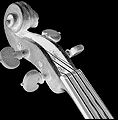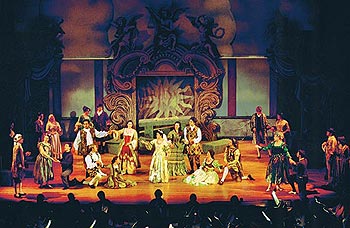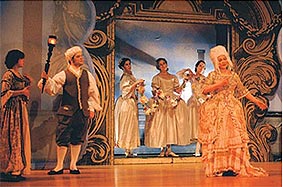
|
|||||||||
 |
Le
Pouvoir de l'Amour Triumphant The baroque opera-ballet had languished on a library shelf until Crawford, in Versailles on a yearlong sojourn supported by a research status grant from Oberlin, plucked it from oblivion. Oberlin's modern premiere of the work was funded by the Florence Gould Foundation and presented with the support of the Conservatory and the Centre de Musique Baroque de Versailles, with assistance from the New York Baroque Dance Company and a cadre of Conservatory students and alumni. Among
the audience members seated in Finney Chapel were Bernard Holland
of The Oberlin Conservatory of Music quietly made music history with its recent modern premiere, in a rare, historically accurate performance, of a forgotten 18th-century opera-ballet, Joseph-Nicolas-Pancrace Royer's Le Pouvoir de l'Amour. Royer is remembered today, when he is remembered at all, for his harpsichord music. Even in his own time, his operas were eclipsed by those of his more powerful contemporary, Jean Philippe Rameau. Yet he was an important figure in his day; indeed, his royal jobs ranged from music teacher to the children of Louis XV to inspector general of the Opera. Oberlin
Conservatory harpsichord professor Lisa Goode Crawford, who launched
the Oberlin project, came upon his operas when she was working on
the critical edition of Royer's harpsichord works, some of which
were based on opera excerpts. Intrigued, she spent a year at the
Centre de Musique Baroque de Versailles creating a performing edition
of When production time came around, the centre sent its choir director, Olivier Schneebeli, to Oberlin to coach the student chorus. Oberlin also enlisted the aid of Catherine Turocy, artistic director of the New York Baroque Dance Company and a superb reconstructor/creator of baroque choreography, and Patricia Ranum, an expert in French rhetorical/musical declamation. Le Pouvoir de l'Amour proved to be well worth the effort. A delightful score, it resounds with elegance, expressiveness, and gentle wit. As befits its subject - the power of love - the opera relies less on high drama and tragedy than those of Royer's predecessor, Jean-Baptiste Lully, and each of its acts, or entrées, has an unusually straightforward plot. In the alle gorical Prologue, Prometheus brings fire and awakens mankind, only to see the evil Passions (hatred, jealousy, etc.) overwhelm his creation. Fortunately, Imagination comes to the rescue, invoking Love to harness those demons. In the first entrée, the mother of Zelide tries to keep her from falling in love but is thwarted; in the third, Apollo himself falls prey to Cupid's arrows and persuades a savage people to drop its habit of blood sacrifice in favor of allegiance to Love. (The Oberlin production omitted the second entrée, which is about King Midas.) Dancing and singing are of equal importance in French opera-ballet, and Le Pouvoir struck that balance eloquently. Framed by a simple, baroque-style set of flats by Don McBride (lacking theatrical facilities, Finney Chapel, the acoustically fine performance space, allowed nothing more elaborate), Victoria Vaughan's formal stage direction meshed fluidly with Ms. Turocy's exquisite dances. While the solo singing, performed by students or recent graduates, did not have total professional polish, it was stylish and well-coached, and there were a few ear-catching standouts. The chorus was excellent, and the choreography, which relies on low leg extensions, 90-degree turnout, and great upper-body expressiveness in its stylized way, was nicely calibrated to match the dancers' different levels. Highlights
included mezzo Melanie Besner's swaggering L'Amour and soprano Ann
Harley's imposing L'Imagination of the Prologue, and the delicious
dance in which the Reprinted from The Wall Street Journal. © 2002 Dow Jones & Company, Inc. All Rights Reserved. Finding
a presenting niche for French baroque opera- For the production, held on February 8 and 9, 2002, Oberlin fielded a cast of singers, dancers, and a 26-member orchestra of current students and professionals, many of them Oberlin alumni, under the musical direction of Crawford. Victoria Vaughan, assistant director of Oberlin Opera Theater, devised the formal yet fluid period stage direction, and Michael Sponseller, an Oberlin alum, led the orchestra. Distinguished visitors included Olivier Schneebeli, choir director from the Centre at Versailles, who trained the chorus, and rhetorician Patricia Ranum, who instructed the cast in declamation. Catherine Turocy, head of the New York Baroque Dance Company, choreographed and staged the dances, bringing along two of her company dancers to take featured roles. The opera proved well worth the effort. Though Royer was eclipsed by his contemporary, Jean-Philippe Rameau (1683-1764), his Le Pouvoir is a delightful score, imbued with elegance, expressiveness, and gentle wit; it is splendidly balanced between singing and dance. Oberlin staged the allegorical Prologue, in which Love and Imagination triumph over the evil Passions (hatred, jealousy, etc.), as well as the first and third entrées. In the first entrée, the mother of Zelide tries to keep her daughter from falling in love, but is thwarted; in the third and more dramatic entrée, Apollo himself falls prey to Cupid's arrows and persuades a savage people to drop its habit of blood sacrifice in favor of allegiance to love. (The Oberlin production omitted the second entrée, which is about King Midas.) Most pleasing of all was the fact that this highly successful realization was a collaboration of professionals and students. It was also a testament, alas rare these days, of how satisfying fully period stagings of such pieces can be. II Reprinted with permission from Early Music America magazine. © 2002 Early Music America. Photos by Larry Kasperek |
||


 Oberlin
Presents Modern Premiere of Royer's Le Pouvoir de l'Amour
Oberlin
Presents Modern Premiere of Royer's Le Pouvoir de l'Amour